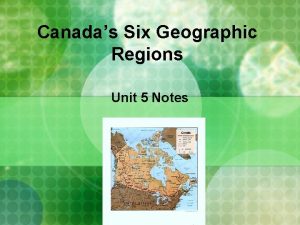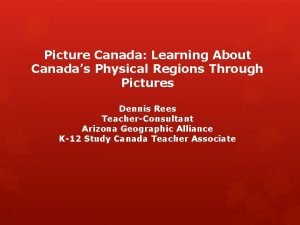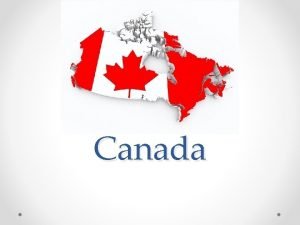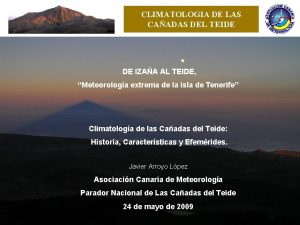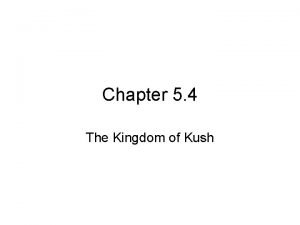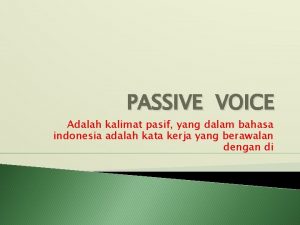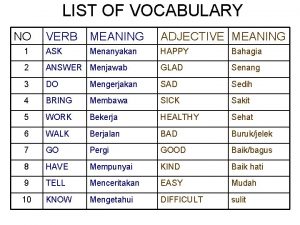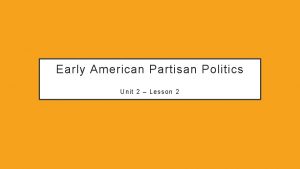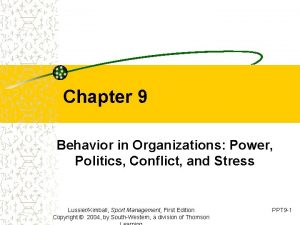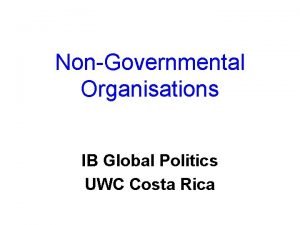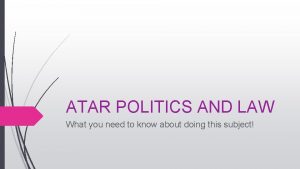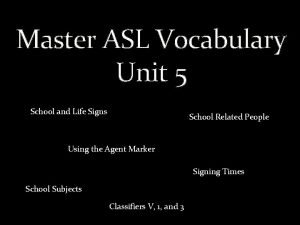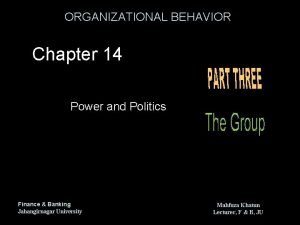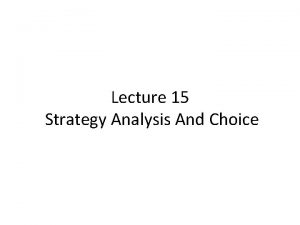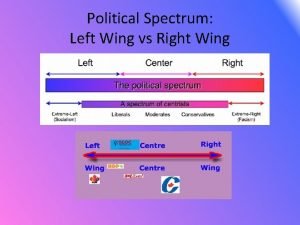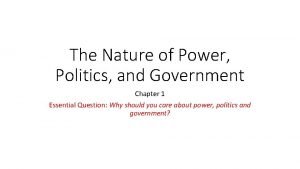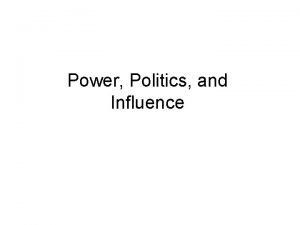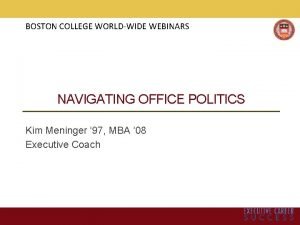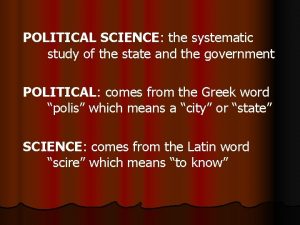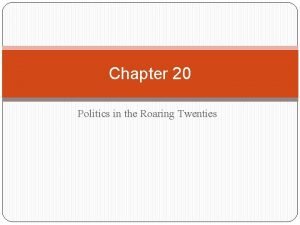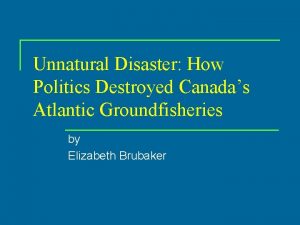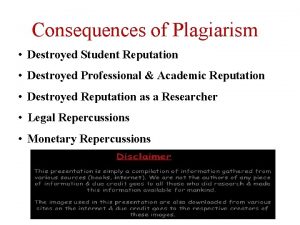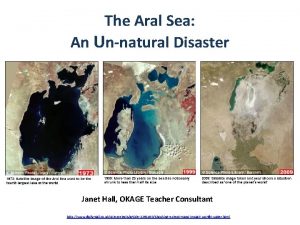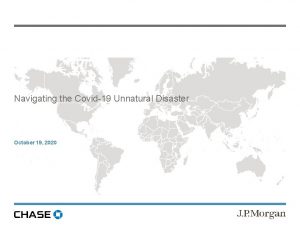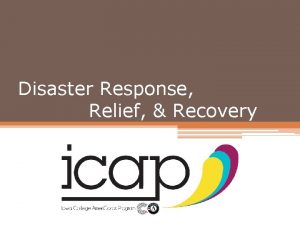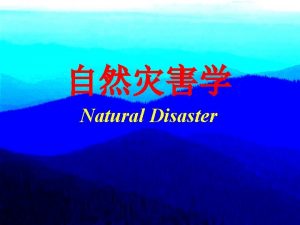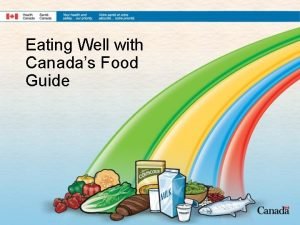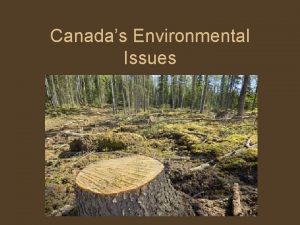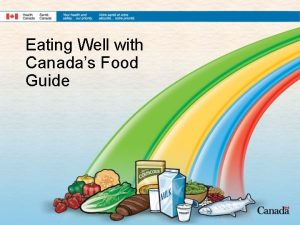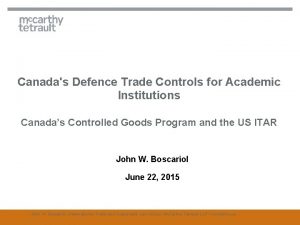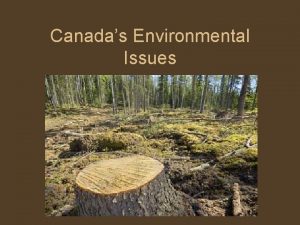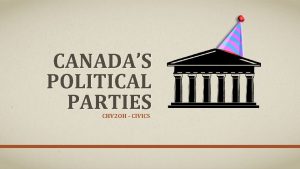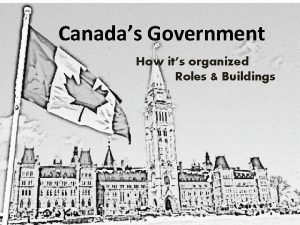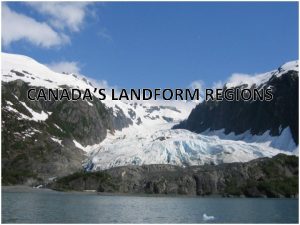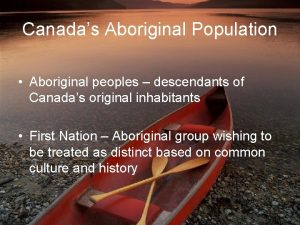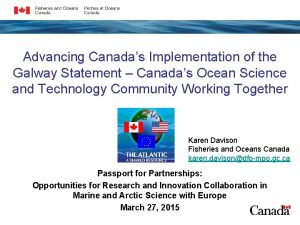Unnatural Disaster How Politics Destroyed Canadas Atlantic Groundfisheries


















































- Slides: 50

Unnatural Disaster: How Politics Destroyed Canada’s Atlantic Groundfisheries by Elizabeth Brubaker

Collapse n n n In 1992, Canada’s fisheries minister, John Crosbie, banned fishing for cod off the northeastern coast of Newfoundland off the southern half of Labrador. The northern cod stock, once one of the richest in the world had collapsed. More bans came in the next few years in more fisheries and on more species of fish. 2

3

Collapse, cont’d n n Despite the fishing bans, many stocks continued to decline. Cod populations dropped to onehundredth of their former sizes. In 1997, fishing on 22 stocks remained prohibited. Scientists worried that the worst-hit stocks might never fully recover. 4

5

6

Economic Disaster n n n Collapse of the Atlantic groundfish was more than an ecological disaster—it was an economic disaster. Fishery closures, which threw 40, 000 fishermen and fish processors out of work, created social and economic chaos throughout Atlantic Canada, where half of the 1, 300 fishing communities depended entirely on the fisheries for their existence. The moratoriums hit Newfoundland especially hard, because fishing has been its major industry. 7

Destruction Could Have Been Avoided n n The destruction of this critically important resource was caused by politicians, pursuing their short-term interest in getting re-elected Politicians subsidized the expansion of the fisheries and set catch levels exceeding those recommended by government scientists. 8

Once Boundless Stocks n n n Cod were so plentiful that in the 17 th century a writer reported “that we heardlie have been able to row a boate through them. ” An 1883 report asserted that “The cod fishery…[is] inexhaustible. ” In 1885, the Canadian Minister of Agriculture predicted, “Unless the order of nature is overthrown, for centuries to come our fisheries will continue to be fertile. ” 9

10

Nature Overthrown n n Cod catches grew from an annual average of 500, 000 tonnes in the first half of the 20 th century to 1. 5 million tonnes in 1968. By 1978, catches had declined to 400, 000 tonnes. After extending to 200 miles the exclusion zone foreign boats, the catch recovered to 500, 000 tonnes in 1982. But it declined to 183, 000 tonnes in 1992, and in 1996—four years after the moratorium—fishermen caught only 13, 000 tonnes of cod. 11

Laying Blame n n Canada’s fisheries managers blamed the collapse on forces beyond their control. Scientists now widely agree that it was politicians and bureaucrats running Canada’s Atlantic fisheries, who permitted—and even encouraged —overfishing. q q The government not only ignored the evidence of overfishing, but attempted to conceal it. The DFO routinely suppressed politically inconvenient research into the causes of the cod decline. 12

Suppressing the Truth n n Top-level bureaucrats at the DFO did their best to silence Ransom Myers’s research. Myers stated “We reject the hypotheses that attribute the collapse of the northern cod to environmental change…. We conclude that the collapse of the northern cod can be attributed solely to overexploitation. ” 13

Bureaucratic Intimidation n n That senior bureaucrats would try to prevent staff scientists from reporting research that blamed government policies for the collapse of the fisheries, is hardly surprising. “Tragically, successive governments abused their virtually complete power over fisheries, managing them not for long-term biological or economic sustainability, but for short-term political gain. ” P. 171 14

How Many Jobs? n n Putting to work as many fishermen and fish processors as possible has long been the goal of Canada’s fisheries managers. Canada’s fisheries would be managed not to maximize sustainable yields, but to increase employment. q “In other words, [up until now] fishing has been regulated in the interest of the fish. In the future it is to be regulated in the interest of the people who depend on the fishing industry. 15

16

Catch Limits n n The DFO confirmed in 1981 that Canada based catch limits not only on what it thought the fishery could bear but also on “the economic needs of coastal fishing communities. ” When the two objectives were in conflict, the economic needs (short-term jobs)—and the votes they bring—always came first. 17

18

Fishing for Subsidies n n Successive governments showered fishing communities with subsidies. After 1977 subsidies skyrocketed. q q Loans at low interest rates to buy bigger boats and sophisticated gear. Cash grants to fishermen and fish processors. Tax exemptions for fuel and equipment. Generous unemployment benefits. 19

Unemployment Insurance n In the Early 1980 s, UI was widely taken for granted as a natural part of fishermen’s income. q q For many years workers had to work only 10 weeks to receive 42 weeks of benefits. By 1990, Newfoundland’s fishermen were receiving $1. 60 in benefits for every dollar they earned in the fishery. 20

Unemployment Insurance to Ensure Unemployment n n n The perverse effects of UI became tragically clear in the 1990 s: Unemployment insurance encouraged people to remain in communities that lacked any promise of a viable future. UI prompted young people to quit school, as they could earn more in the UI-supplemented fishery than they could working in many year-round jobs. 21

UI cont’d n n Of Newfoundland’s fishermen, 83 percent have not graduated from high school, and 37 percent haven’t attended high school. UI contributed to overcapacity in the fishing industry. q q The UI program lured workers into an industry that could not support them. Following the UI changes in 1972, the number of fishermen doubled. 22

A Vicious Circle n n n As the number of workers in the fishing industry increased, so did the capacity of their boats and plants. The artificially inflated workforce and its artificially inflated investments—boats and plants —pressured politicians to maintain artificially inflated catch limits. Loans had to be repaid and workers needed to qualify for UI so the politicians complied— perpetuating a vicious circle that only the collapse of the fishery could break. 23

Early Warnings Ignored n n As early as 1970, a federal cabinet memorandum described the fishing industry as overcapitalized. Fishermen, processors and provincial governments all pressured the federal government for expansion. q Between 1974 and 1981, the number of licensed fishermen in Atlantic Canada increased 45%, while the number of processing facilities expanded 35%. 24

Continued Warnings Ignored n n n In the 1980 s more reports warned of overfishing, but they continued to be ignored. By 1993, it was too late. The groundfish stocks had collapsed. “Decades of subsidies…had created a false economy based on a resource that no longer existed. Governments had paid people to destroy the fishery. ” p. 180 25

Fruits of Canadian Citizenship n n The bulk of federal spending in the 1990 s has gone to the Atlantic Groundfish Strategy (TAGS) in an attempt to shrink the industry. The program created perverse incentives. q q When TAGS benefits run out, recipients can return to UI. The benefits are so generous that continued attachment to the fishery is profitable. 26

The Atlantic Groundfish Strategy (TAGS) n n n In its “Recent Account of Canada’s Atlantic Cod Fishery, ” the DFO reports: TAGS had two main components: income adjustment measures and measures to achieve a 50 per cent capacity reduction and industry renewal. Emphasizing labor adjustment measures, TAGS was also designed to help individuals to access new career training and job opportunities outside the fishery. The income assistance has been too generous— people have incentives to remain tied to their fishing communities to remain on the dole. 27

No Fish and Only a 35% Reduction n n Between 1992 and 2001, the Government of Canada spent $3. 9 billion on income support, industry adjustment measures, and economic development assistance programs for the Atlantic fishing industry. A total of 1, 769 fishers opted for early retirement during this time, and 3, 686 licenses were retired through the four economic assistance programs which began in the 1990 s. There were 17, 200 Atlantic groundfish license holders in 1992 and 10, 372 in 2002, representing a decline of roughly 35 per cent. In fact, of the 6, 380 groundfish license holders entitled to fish 2 J 3 KL, 3 Pn 4 RS, and 4 TVn cod in 2000, only 3, 882 actually fished for cod – mostly in small quantities – and almost half relied on cod for less than 10 per cent of their total fishing income. 28

Why Leave the Fishery? n n On April 24, 2003, the Minister of Fisheries and Oceans announced the closure of the cod fisheries in 2 J 3 KL, 3 Pn 4 RS, and 4 TVn. At the same time, the Minister and his colleagues from ACOA and CED-Q outlined a $50 million, four-part action plan to assist individuals and communities that would be most affected by the closure…. Temporary financial assistance was also made available to affected fishers and plant workers while the short-term job creation projects were being implemented, through the $27 -million Temporary Fishers Income Program (TFIP), which was announced by the Minister of Human Resources and Development on June 3, 2003. 29

Messy Information n As the fishery expanded, scientists and fishermen alike cautioned that fish stocks were declining. q q n Inshore fishermen complained of declining catches, hired three biologists to review the government’s report. Biologists believed that the report overestimated the fish biomass by 55%. The DFO’s desire for consensus and a report without ambiguity, meant that biologists’ concerns did not get communicated in the report. 30

The Politics of Truthful Information n “The scientists understood that they derived their funding and authority from politicians who relied on their help to achieve political objectives. ” p. 186. q q Political realities prevented scientists from disclosing the full scientific truth. Warnings never made it into the task force’s report, which overflowed with wildly optimistic forecasts of stock growth. n These predictions encouraged further expansion of the industry, justifying unsupportable investments in harvesting and processing. 31

Bureaucratic Rules n n n Civil service rules prevented staff scientists from reporting to the media. Designated spokespersons were to speak to the media only on matters of fact or approved government policy. Breaking these guidelines may be grounds for dismissal. q Hence, scientists could not express their concerns about the depleted fish stocks outside of the DFO. 32

Total Allowable Catches n n n TACs of 20% of estimated stocks may have been consistent with sustainable harvests. Between 1977 and 1985, TACs were perhaps twice as high as they should have been. CAFSAC advised in 1989 that the TAC be lowered from 266, 000 tonnes to 125, 000 tonnes. q Those in charge lowered TAC to 235, 000 tonnes— 88% higher than recommended. 33

Ignoring Scientists Advice n n John Crosbie in announcing the TAC for 1989 stated, “A politician has to be concerned about protecting both the fish stocks and the livelihood of fishermen. We couldn’t suddenly cut the TAC by more than half. ” He added, “If we accepted the new TAC…Both National Sea and Fishery Products International would have gone bankrupt. ” 34

TACs cont’d n n Setting TACs at unsustainable levels had already become department policy. The DFO had introduced what it called “the 50% rule, ” allowing managers to ignore their longstanding target of limiting catches to about 20% of the spawning stock. q q This announcement set the policy DFO would follow until the cod stock disappeared. Failing to respond in 1989 meant destroying the cod stocks and the jobs it wanted to keep. 35

Responding to the Voters n n n John Crosbie later admitted that by keeping the TAC high, “FPI might be able to keep its fish plant open at Trepassey in my constituency. Crosbie had his eye on votes rather than on the fish. In 1991, in response to protests by fishermen the government raised the TAC. 36

1992 n n In 1992, Crosbie realized that even a 125, 000 -tonne TAC was too high. “The political pressures on me…to do something— anything—about the fishery made my job almost unbearable. ” By July, CAFSAC estimated that the cod stock had fallen to as low as 48, 000 tonnes. Only then did Crosbie impose a moratorium on fishing for northern cod. 37

38

Too Optimistic or Political Calculation? n n On July 2, 1992, the Fisheries Minister (John Crosbie) announced a two-year moratorium on cod fishing in 2 J 3 KL to allow "the spawning biomass to recover quickly to its long-term average. " A two-year Northern Cod Compensation Adjustment and Recovery Program (NCARP) was announced on July 17, 1992, comprising income replacement benefits, skills training, professionalization and certification, and options for harvesters to voluntarily take early retirement or to voluntarily retire their fishing licensces. 39

40

“Mistakes Were Made” n In November 1993, the Task Force on Incomes and Adjustment in the Atlantic Fishery presented its final report …. Entitled, Charting a New Course: Toward the Fishery of the Future, the report blamed three fundamental problems for the predicament of the Atlantic groundfishery: over-dependence, too much fishing pressure on the resource, and an over-capacity in harvesting and processing. Simply put, there were too many fishers and boats in the cod fishery, and not enough fish to catch. 41

Would You Trust Him? n The Fisheries Minister (Brian Tobin) responded directly to the … Report on November 16, 1993, by pledging to rebuild the Atlantic fishing industry and fishing communities using four key strategies. He promised to create a partnership between the fisheries minister and the fishing industry and to restore reliability and confidence in conservation and management decisions. He also vowed to create a viable fishing industry and to restore the economic base of fishing communities. 42

Announced Short-Term Moratoriums Keep Fishermen in Place n n n Shortly after issuing his response, the Minister received a bleak report from the FRCC regarding Atlantic groundfish stocks. On December 20, 1993, the Fisheries Minister announced that all major cod fisheries would be suspended and that quotas for other groundfish species would be sharply restricted in 1994. It was estimated at this time that up to 35, 000 fishers and plant workers would be out of work in 1994, as a result of closures and restrictions since 1991. In keeping with his commitment to these Canadians, the Minister eased AGAP eligibility rules as a "matter of basic fairness. " The amendments ensured that the income support measures were more consistent for individuals, regardless of their province of residence. 43

Atlantic cod catch 1950 -2002. Northeast Atlantic (blue), northwest Atlantic (green) and total (red) 44

45

Surrendering Control? n n With an eye on the next election, politicians have chosen short-term payoffs with disastrous long-term consequences. No politicians or bureaucrats have been held accountable for making decisions that destroyed the groundfish stocks. q “Government control is simply not a sustainable method of fisheries management. Political and bureaucratic structures being what they are, government managers have neither the incentives nor the tools to make the best long-term decisions. ” p. 201 46

Avoiding Tragedy n n “The transfer of ownership and control of fisheries from central governments to fishermen, fishing companies, or fishing communities changes…incentives. Exclusive, permanent property rights promote stewardship. ” With property rights, fishermen gain powerful incentives to maximize their stock’s value, not just today, but in the future. ” p. 202 47

Conclusion n In 1998, Ransom Myers observed, “The disaster in the cod fishery is now worse than anyone expected…. It may be a generation before we see a recovery of the cod. That a five-hundred-year-old industry could be destroyed in fifteen years by a bureaucracy is a tragedy of epic proportions. ” 48

Updating Brubaker n A decade ago, cod stocks “crashed” in Atlantic Canada, an event generally agreed to have been the result of “overfishing. " Despite a ten year fishing moratorium, however, these stocks are showing no convincing signs of recovery. Most perplexing, perhaps, is the continued, and increasingly acute, absence of older, mature fish from these stocks. With 10 years to grow without fishing pressure, there should now be a significant stock component of larger adult fish. But there is not…and in fact the oldest age now attained by cod on the Grand Bank of Newfoundland, is less that it was ten years ago. Stock assessment indicators for cod in general continue to fall. 49

Slow Recovery, If Ever n n The northwest Atlantic cod has been regarded as heavily overfished throughout its range, resulting in a crash in the fishery in the United States and Canada during the early 1990 s. The fishery has yet to recover, and may not recover at all because of a possibly stable change in the food chain. Atlantic cod was a top-tier predator, along with haddock, flounder and hake, feeding upon smaller prey such as herring, capelin, shrimp and snow crab. With the large predatory fish removed, their prey has had a population explosion and have become the top predators. Young Atlantic Cod have become the prey in the northwest Atlantic, making recovery extremely slow as they do not spawn until about 7 years of age. 50
 貝合わせ 意味
貝合わせ 意味 Unit 5 food national geographic
Unit 5 food national geographic Canadas physical regions
Canadas physical regions Canadas landforms
Canadas landforms Who is canadas head of state
Who is canadas head of state Canadas climate
Canadas climate 90 of the canadian population lives within
90 of the canadian population lives within What is canadas economic system
What is canadas economic system Whats canadas longest river
Whats canadas longest river Electromagnetismo
Electromagnetismo Temperatura en las cañadas del teide
Temperatura en las cañadas del teide How was the statue of zeus destroyed
How was the statue of zeus destroyed Nubia conquered egypt
Nubia conquered egypt Presuppositionalism destroyed
Presuppositionalism destroyed The court will try the case next week
The court will try the case next week Replacement of destroyed tissue
Replacement of destroyed tissue Energy can be created and destroyed
Energy can be created and destroyed Energy cannot be created or destroyed
Energy cannot be created or destroyed Which parts of tohirin’s house were destroyed?
Which parts of tohirin’s house were destroyed? Who destroyed jerusalem in 607 bce?
Who destroyed jerusalem in 607 bce? Energy can be created and destroyed
Energy can be created and destroyed Verb 3 cute
Verb 3 cute Reconstruction and its effects chapter 4 section 4
Reconstruction and its effects chapter 4 section 4 What is politics
What is politics Lesson 2 partisan politics
Lesson 2 partisan politics Bolton romanticism amp; politics 1789 1832 download
Bolton romanticism amp; politics 1789 1832 download Power and politics organization theory
Power and politics organization theory Comparative theories politics a level
Comparative theories politics a level Power, politics and conflict in organizations
Power, politics and conflict in organizations The guerrilla girls' comic politics of subversion
The guerrilla girls' comic politics of subversion Uwc costa rica global politics
Uwc costa rica global politics Politics and law atar
Politics and law atar Sign politics
Sign politics The politics of reconstruction chapter 12 section 1
The politics of reconstruction chapter 12 section 1 Ap us government and politics unit 1 study guide
Ap us government and politics unit 1 study guide Communion 000yearold holy mystery
Communion 000yearold holy mystery Philosophy, politics and economics michael munger
Philosophy, politics and economics michael munger Renaissance key terms
Renaissance key terms Work experience politics
Work experience politics Heywood global politics
Heywood global politics Preferred power tactics by influence direction
Preferred power tactics by influence direction Politics of strategy choice
Politics of strategy choice Left vs right politics
Left vs right politics Chapter 7 section 3 politics in the gilded age
Chapter 7 section 3 politics in the gilded age The nature of power politics and government
The nature of power politics and government Unethical political tactics and strategies
Unethical political tactics and strategies What are politics
What are politics Political science importance
Political science importance World politics in a new era
World politics in a new era Power, politics and conflict in organizations
Power, politics and conflict in organizations Chapter 20 section 2 the harding presidency
Chapter 20 section 2 the harding presidency

